
VOLUME 1, NO. 2 JAN/FEB/MARCH 2022
C larksville-Montgomery County, Tennessee

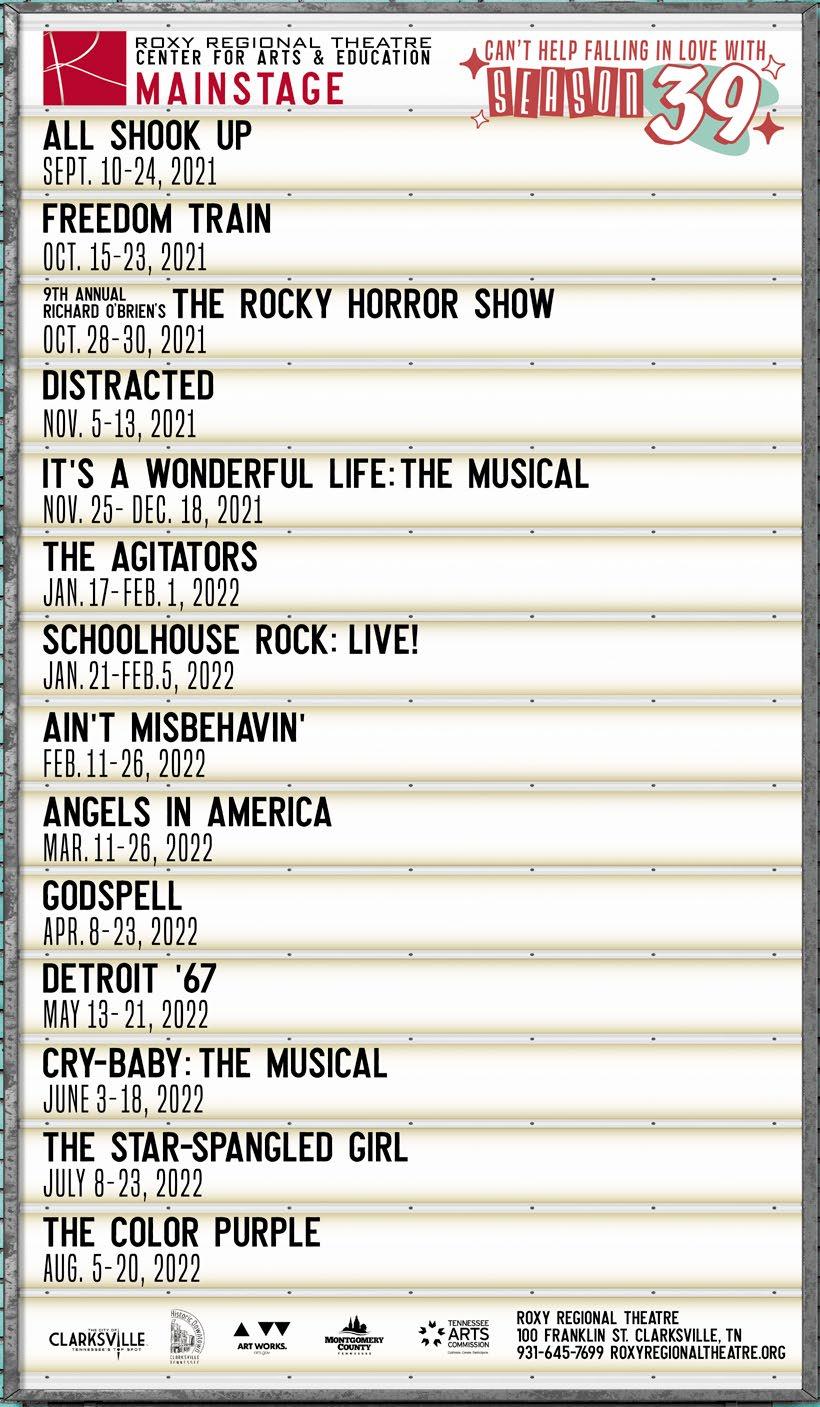 EXECUTIVE DIRECTOR
Frank Lott
MANAGING EDITOR
Becky Wood
EXECUTIVE DIRECTOR
Frank Lott
MANAGING EDITOR
Becky Wood
MARKETING
DESIGN MANAGER Yvette Campagna
MARKETING COMMUNICATIONS MANAGER
Maegan Collins
MEMBERSHIP & MARKETING COMMITTEE CHAIRMAN
Larry Richardson
CONTRIBUTING WRITERS
Alexis Clark
Terri Jordan
Mike Oates
John O’Brien
CONTRIBUTING PHOTOGRAPHERS
John Juanito
HISTORY, ARTS AND CULTURE INTERSECT AT THE CORNER OF SECOND & COMMERCE
I must admit that the rollout of the very first issue of Second & Commerce brought back long-faded memories of the anticipation of bringing home a new baby. The planning, preparation and shared anxiousness were similar emotions in each phase of the process. Finally, when the great moment arrives, you check to make sure all the parts are there and in the correct places.
EXECUTIVE DIRECTOR
Well, a new magazine doesn’t quite compare to bringing home a newborn, but a lot of those first-time parental feelings re-surfaced during the “delivery.” Then came the joy of sharing the newest member of the family with friends and neighbors. As the “proud parents” of Second & Commerce, we have been overjoyed at the reception you have given our quarterly journal and appreciate all the positive comments about the Museum’s newest addition.
The mission of this publication is to foster creativity and champion our area’s unique cultural diversity. SECOND & COMMERCE expands the Customs House Museum & Cultural Center’s purpose through supporting the arts community, exploring local history and telling stories about the past, present and future of Clarksville.
As the journal begins its new life, we hope you will join us in “rearing” this young’un. I digress by using the axiom it takes a village... you know the rest. Yet if this journal is to reach its full potential, it will require the encouragement, collective wisdom and documentation of the many important life stories that each of you holds dear… and hopefully are willing to share. Granted, this will take time, thoughtful research and maybe some amount of courage to bring this journal from adolescence to maturity. As the journey unfolds, we welcome your input, observations and suggestions about topics and interesting people, places and events that pertain to the history, arts and culture of Clarksville-Montgomery County. By doing so, you will ensure that Second & Commerce will grow and thrive as a vital family member of our community.
Jamie Durrett, Chair
Thomasa Ross, Vice-Chair
Paige Adkins
Frazier Allen
Dan Black
Kell Black
Joe Creek*
Lawson Mabry
Linda Nichols
Morgan Knight*
Wes Sumner
Larry Richardson
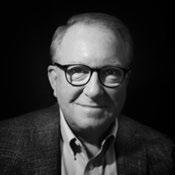
Vondell Richmond*
Eleanor Williams*
*denotes ex-officio

SECOND & COMMERCE / 1
am–5 pm Sundays 1–5 pm Closed Mondays
@customshousemuseum #customshousemuseum
HOURS OF OPERATION Tuesdays–Saturdays 10
customshousemuseum.org
Frank Lott
CUSTOMS HOUSE MUSEUM & CULTURAL CENTER BOARD OF TRUSTEES (As of December 2021)

2 / SECOND & COMMERCE 1 / Director’s Letter 4 / Arts & Culture Calendar 24 / Volunteer Spotlight 25 / Seasons: The Museum Store 26 / Happening at the Museum 32 / Connect with Us TABLE OF CONTENTS CONTACT Advertising Inquiries Arts & Culture Events Article Submissions Please email Becky Wood at becky@customshousemuseum.org customshousemuseum.org/ secondandcommerce The Clarksville Montgomery County Historical Museum (d.b.a. Customs House Museum & Cultural Center) is designated by the IRS as a 501 (c)(3) non-profit organization. © Customs House Museum & Cultural Center 2022-01/2022-4M Uncommon Aesthetics & Exceptional Furnishings 120 Franklin St. 131FranklinSt. Ste. 109 @theclarksvillecollection @journeyseyestudio C M Y CM MY CY CMY K CC JE color ad 7.5x5.pdf 1 9/1/21 1:33 PM Quilted Wall Tapestry Ludie Amos, Artist Courtesy of the Artist See full story on page 9. ON THE COVER:
IN THIS ISSUE / FEATURES
Dr. Burt’s Legacy: Alive & Well
Dr. Robert T. Burt opened Clarksville’s first hospital in 1906, overcoming institutional obstacles and breaking through color barriers. His immeasurable impact is still felt today, beyond the Burt name alone.
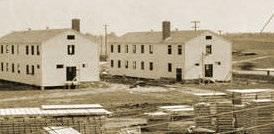

Ludie Amos, Clarksville Treasure
Celebrated local artist Ludie Amos has spent decades telling stories of her culture and upbringing through painting, quilting, sculpting, tapestry and doll making. She is a recent recipient of the Folklife Heritage Award from Governor Lee and the Tennessee Arts Commission.

The Reemergence of the Gateway Chamber Orchestra

After nearly two years without an audience, the Gateway Chamber Orchestra is back on stage in Clarksville. In the meantime, their digital endeavors have kept the orchestra active in new and creative ways.
Tennessee Wings of Liberty Military Museum
The Tennessee Wings of Liberty Military Museum aims to educate, honor and inspire. Mike Oates of the Fort Campbell Historical Foundation provides an update on this long-awaited community project.
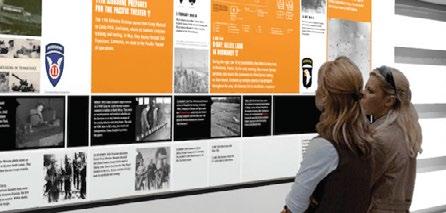
“Local Sentiment in Favor of a Camp Was Very Positive”
Over the past 80 years, local lore has churned up a variety of stories about how the U.S. Government chose this area for such a significant Army installation. Fort Campbell Historian John O’Brien clears the air, and tells the real story of how the city of Fort Campbell came to be.
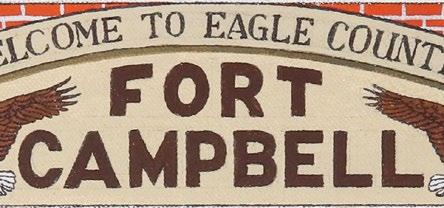
Gateway to Eagle Country
Joining the growing ranks of public art in Montgomery County is a railroad bridge mural celebrating the cities of Clarksville and Fort Campbell. Artist Paul Jones’ winning submission for the project was inspired by the history of the two adjoining towns.
Rising Voices: The Bennett Prize for
Figurative Realist Painters
Women
The Bennett Prize is the largest art award ever offered solely to women figurative realist painters. Interviews with winners Aneka Ingold and Ayana Ross give unique insights into their artistic processes and personal journeys.

SECOND & COMMERCE / 3
6 /
9 /
12 /
15 /
16 /
23 /
27
/
CURRENT
John Guider: Journeys THROUGH JANUARY 23
Jim Diehr: Visual Songs, Many Verses THROUGH JANUARY 30
ARTS & CULTURE CALENDAR
JANUARY
FIRST THURSDAY ART WALK
Downtown Clarksville Thursday, Jan 6 | 5-8pm
DAC WATERCOLOR ARTISTS
Downtown Artists Co-op Jan 6 – 29
Opening reception Jan 6 | 5pm
KOREAN LUNAR NEW YEAR KICKOFF
Customs House Museum & Cultural Center Saturday, Jan 15 | 11am
CLARKSVILLE COMMUNITY CONCERT ASSOCIATION PRESENTS: DENYCE GRAVES, MEZZO SOPRANO
Austin Peay State University Mabry Concert Hall Sunday, Jan 30 | 3pm
CHRISTINA A. WEST: MERE MORTALS
The New Gallery, Austin Peay State University Jan 12 – Feb 11
MLK BIRTHDAY CELEBRATION

Burt-Cobb Recreation Center Monday, Jan 17 | 4:30pm
FEBRUARY
FIRST THURSDAY ART WALK
Downtown Clarksville Thursday, Feb 3 | 5-8pm
ANNUAL REGIONAL JURIED PHOTOGRAPHY EXHIBITION
Downtown Artists Co-op Feb 3 – 26
Opening reception Feb 3 | 5pm
CECA VISITING ARTIST SPEAKER SERIES: JEAN SHIN

Austin Peay State University Art + Design Building Tuesday, Feb 8 | 6pm
APSU
Austin Peay State University Trahern Theatre
Friday, Jan 21 | 7:30pm Saturday, Jan 22 | 2pm & 7:30pm Sunday, Jan 23 | 2pm
GATEWAY CHAMBER ORCHESTRA PRESENTS: ROMANTIC MELODIES
Austin Peay State University Mabry Concert Hall Sunday, February 13 | 4pm
THE SURRENDER OF CLARKSVILLE
Fort Defiance Civil War Park and Interpretive Center Saturday, Feb 19 | 10am
CLARKSVILLE COMMUNITY CONCERT ASSOCIATION PRESENTS: SOTTO VOCE TUBA QUARTET
Austin Peay State University
Mabry Concert Hall Sunday, Feb 20 | 3pm
4 / SECOND & COMMERCE
THEATRE AND DANCE PRESENTS: THE WOLVES
& UPCOMING
MUSEUM EXHIBITS
Our Korean Culture
7 – FEBRUARY 27 New to the Museum Collection
11 – FEBRUARY 20 The Infirmary JANUARY 11 – APRIL 17 Rising Voices 2: The Bennett Prize for Women Figurative Realist Painters FEBRUARY 3 – APRIL 24 Aneka Ingold: Transfiguration FEBRUARY 3 – APRIL 24 Baskets & Bowls: Art of the Southwest FEBRUARY 8 – APRIL 3 Breaking Through: The Rise of American Women Artists MARCH 5 – MAY 29 Learn about Museum exhibits, programs and more at customshousemuseum.org
The Petite Voyage: Small Works by Paul Harmon THROUGH FEBRUARY 6 Celebrating
JANUARY
JANUARY
LISTENING: THE FOURTH STRING; RAHELEH FILSOOFI, REZA FILSOOFI
The New Gallery, Austin Peay State University
Feb 21 – Mar 25
MARCH
FIRST THURSDAY ART WALK
Downtown Clarksville
Thursday, Mar 3 | 5-8pm

FILIZ GRIFFIN: PORTRAITS AND FIGURES
Downtown Artists Co-op Mar 3 – 26
Opening reception Mar 3 | 5pm
CLARKSVILLE FILM FESTIVAL



Roxy Regional Theatre Saturday, Mar 12
GATEWAY CHAMBER ORCHESTRA PRESENTS: LA PASIÓN

Austin Peay State University Mabry Concert Hall
Saturday, Mar 19 | 7:30pm Sunday, Mar 20 | 4pm
MAGIC OF THE MIND WITH JEFF AND KIMBERLY BORNSTEIN
Customs House Museum & Cultural Center's Turner Auditorium Friday, Mar 18 & Saturday, Mar 19
CECA VISITING ARTIST SPEAKER SERIES: KENTURAH DAVIS
Austin Peay State University Art + Design Building Thursday, Mar 24 | 6pm
CECA VISITING ARTIST SPEAKER SERIES: LATOYA HOBBS
Austin Peay State University Art + Design Building Tuesday, Mar 29 | 6pm
SECOND & COMMERCE / 5 THE ONLY CICCHETTI BAR IN TN CRAFT COCKTAIL BAR FULL SERVICE COFFEE BAR CLARKSVILLE’S ONLY TRUE WOOD FIRED PIZZA OVEN BREAKFAST LUNCH DINNER Historic Downtown Clarksville 111 Franklin Street
DR. BURT’S LEGACY: ALIVE & WELL
BY ALEXIS CLARK, STAFF WRITER AT THE LEAF-CHRONICLE
DR. BURT'S HOME INFIRMARY
Born in Attala County, Mississippi on November 25, 1873, Burt was the third child of ex-slaves Robert and Sylvia (Sanders) Burt, according to Tennessee State University's library data.
He was highly educated, graduating from the Nashville-based, historically Black Walden University in 1893 and Meharry Medical College in 1897. Burt's post-graduate education and work history included stints at Harvard University and the Mayo Clinic, where he observed new surgical procedures.
Burt relocated to Clarksville in the early 1900s and opened a home infirmary on Front Street, now known as Riverside Drive.
Shortly after the dawn of the 20th century, Dr. Robert T. Burt, then 33, made medical history when he opened the city's first hospital on March 6, 1906. It was a day that led to the breaking of color barriers in a town where nearly half the population was African American at the time.

And it is a day that continues to resonate over a century later.
When Tennova Healthcare General Surgeon Dr. Ronald Atwater Jr. saw a painting of Dr. Burt hanging near the hospital's main entrance in 2019, he realized Burt's vision had come full circle. He couldn't help but smile when he researched Burt, as the two are both African American surgeons who are Meharry Medical College graduates.
"Physicians like Dr. Burt have paved the way for my generation of physicians, and I intend to do the same for generations to come," Atwater said. "I know that as an African American physician, I represent more than just myself."
The Home Infirmary initially stood on a hillside overlooking the Cumberland River. It was operated by Burt and several doctors and nurses, including Burt's wife, Emma, a nurse. It offered assistance to African American patients, and it was the only hospital in town until 1916.
By 1923, the infirmary had 32 rooms with the modern conveniences of the time period. It was recognized by the National Medical Association and operated for more than 40 years, eventually offering services to patients of all races.
Burt contracted with the Black Diamond Mining Company to care for the business's African American employees, and he treated the obstetric patients at Fort Campbell before Blanchfield Army Hospital was constructed, library documents say.
6 / SECOND & COMMERCE
Clarksville's medical history will forever align with Black heritage.
Dr. Robert T. Burt (1873-1955) Archives Collection, Customs House Museum & Cultural Center
During his career, Burt performed roughly 400 procedures each year, according to Clarksville historian Jackie Collins.
"He had a clinic for needy children, where he removed their tonsils if needed, and he performed C-sections before it became a common practice," Collins said, noting that Burt also performed surgery to remove a bullet from the brain of one of his patients, thereby saving the man's life.
Burt ran his hospital until Clarksville Memorial Hospital opened its doors in August 1954, Collins added.

'KNOCKED DOWN WALLS INTO STEPPING STONES'
In 2020, Montgomery County's population surpassed 220,000 residents, 20% of which are African American.
Across the nation, men and woman who identify as African American make up only 5% of physicians, according to data by the Association of American Medical Colleges.
For Atwater, joining the medical profession as an African American was a rigorous task. With systemic barriers and historic oppression, the journey is far from easy, especially with few role models.
But Burt set the tone over a century ago in the Clarksville community, making it known that if there is a will, there is a way.
"The journey is long and tough, and it will sharpen you. Know that it is possible," Atwater said, speaking to the next generation of would-be physicians and professionals. "Many have come before you and have created a path. They have knocked down walls into stepping stones. Keep that path worn and do not let it be overgrown by brush."
"And great people who have gone before me, who have helped better society as a whole despite different prejudices, discrimination... yet they see the greater good,” he explained.
Fryer said the past is key, showing exactly what a person can accomplish when following their dreams.
“When we realize we are here to serve other people, like Dr. Burt did, it makes a huge impact," he said. "It is immeasurable."
ACKNOWLEDGING DR. BURT, THEN AND NOW
Burt survived the struggles Black physicians faced in his day, Collins explained.
"His determination was what led to his success," Collins said. "There were some Black doctors before Dr. Burt and many after him, but he made a profound impact on the City of Clarksville."
Collins said Burt's achievements should be acknowledged and seen all over.
Dr. Greg Fryer agreed. He and his wife, Erien, have owned the Clarksville-based Medical Direct Care for the past eight years. As a physician who identifies as African American, Fryer said it feels as if he is standing on the shoulders of giants.
In addition to his duties as a physician, Burt was a member of the Clarksville Chamber of Commerce, the Board of Trustees at Meharry Medical College and the Examining Board during World War I, according to Collins. He was the state chairman of the Executive Committee of the Interracial Commission and served on the Welfare Board of Clarksville.

SECOND & COMMERCE / 7
Dr. Burt’s Infirmary, Clarksville, Tenn. Postcard, ca. 1919
Courtesy of Austin Peay State University Felix G. Woodward Library, Archives & Special Collections
Mrs. Emma T. Burt, Graduate Nurse, Superintendent & Anesthetist Archives Collection, Customs House Museum & Cultural Center
"Physicians like Dr. Burt have paved the way for my generation of physicians, and I intend to do the same for generations to come."
-Dr. Ronald Atwater Jr.
Burt received the Rosenwald Award and Clarksville's Burt Elementary School is named in his honor. The school site includes an historical marker that notes its original name, Burt High School.
Collins added that Burt's accomplishments should be taught in school, and his name should be displayed in front of Clarksville's and Fort Campbell's hospitals.
Because Dr. Burt was an educator.
Because Dr. Burt was a believer.
Because Dr. Burt was an African American pioneer who overcame barriers and paved the way for future medical professionals in Clarksville and beyond.

The Infirmary, an exhibit about Dr. Burt and his colleagues, is on view at the Customs House Museum & Cultural Center from January 11 to April 17. A historical marker stands at the site of Dr. Burt’s Infirmary near the corner of Riverside Drive and Barker Street.
tnafricanamericanhistoricalgroup.com theleafchronicle.com
Nationally Recognized Healthcare Right Here in


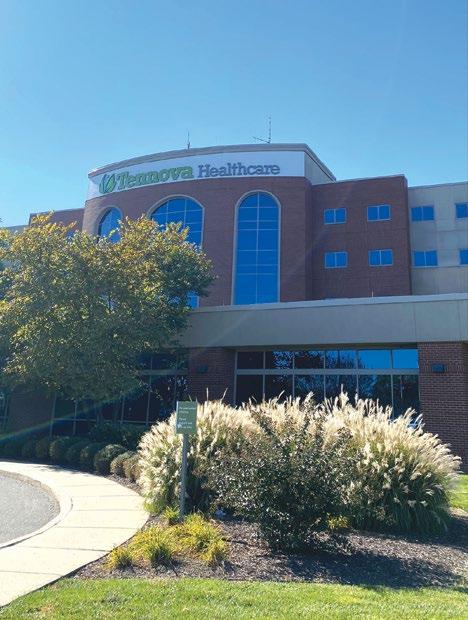
Clarksville.
Nothing means more to us than your good health. In fact, helping our neighbors live healthier lives is our incentive for constantly working to enhance the quality of care we provide. So when you see the certifications and accreditations we’ve earned, you can take pride in knowing you are our motivation.

TennovaQuality.com

8 / SECOND & COMMERCE
TOP: Harriet Manson, Sarah Jackson, Mary Nesbitt BOTTOM: Stella Burt, Head Nurse and First Assistant; Little Em T. Burt, daughter of Robert and Emma; Mary Hatcher, Surgical Nurse and Second Assistant Archives Collection, Customs House Museum & Cultural Center
LUDIE AMOS, CLARKSVILLE TREASURE
 BY TERRI JORDAN, CURATOR OF EXHIBITS
BY TERRI JORDAN, CURATOR OF EXHIBITS
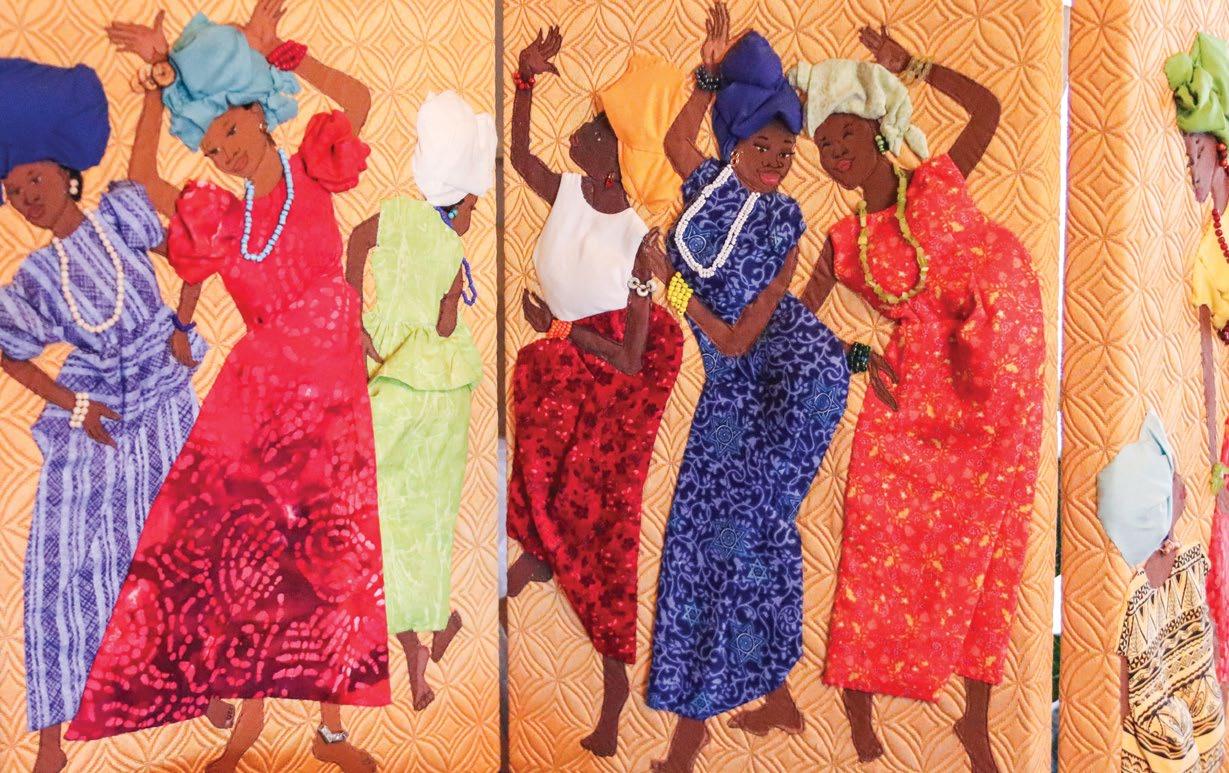
A person’s home is a reflection of their personality – a fact that is fully on display in the home of Ludie Amos. Any visitor is sure to admire everything from the bold floral wallpaper to her iconic handmade clay dolls that line the room right when you walk through the front door. Sitting together in her living room in North Clarksville, it is clear that Ludie Amos is a storyteller.
Originally from Georgia, Ludie moved to Clarksville in 1959, where she went on to become a fixture of the Tennessee craft scene. She has cemented herself as one of Clarksville’s finest artists and storytellers, known especially for her dolls and tapestries. This past October, Ludie received a Tennessee Governor’s Arts Award, the state’s highest honor in the arts. The Folklife Heritage Award specifically honors long-term achievements within art forms that are rooted in the traditional or ethnic culture of Tennessee.
Ludie began making her figures out of Styrofoam, in the shapes that represented the people she encountered throughout her life. As she mastered her craft, she began creating her dolls in themed series using polymer clay. To create the Artisan Collection, she studied the exhibiting artists at craft fairs she attended. Ludie hand-makes all the clothing and accessories that accompany each figure from the fabrics of old clothes and quilting scraps. Her wall hangings are representative of her past experiences, conveying a rich and fulfilling life. Her home reflects those same values.
“Everything on the wall means something to me when I see it,” she explained. “Some of it is other people’s work, but I can conjure up a story, and it has meaning to me.”
SECOND & COMMERCE / 9
Quilted room divider Courtesy of the Artist
She lights up when talking about a painting on the wall of Euclid Beach Park in Cleveland, Ohio, where she moved at age nine after her mother passed away. When discussing recent works, she zeroes in on a piece picturing the black walnut tree that grew tall outside her childhood home, which is still standing today.
“I'm 86 years old... you don’t want to forget home, where you came from, who was there. There are things that are precious to remember.”
I have worked with Ludie since 2010 in the museum capacity. I remember marveling at the large old-timey schoolhouse she was constructing on her dining table, with its tiny globe and miniature books with writing on their pages. No detail was left out. Another visit to her home brought the discovery of her fabulous
wall hangings, whose quilted churchgoers and children playing street ball were newly told stories made of long-lived fabrics.
Ludie’s pieces tell the story of her upbringing, celebrating African culture and family life in the rural south. She comes from a family of nine siblings, who were all very encouraging of her artistic passions, which from a young age included drawing, fashion and interior design. Her mother thought she would become a schoolteacher because she liked to keep her hands busy, and she did work for many years as a school secretary while she raised a large family of her own.
As we discuss her work, Ludie’s eldest granddaughter Adrienne sits across the room and is quick to point out her grandmother’s modesty.
“She lives art. These curtains and window treatments – they're all handmade,” explained Adrienne, pointing to features around the room. “She has redone this house so many times...

10 / SECOND & COMMERCE
“I'm 86 years old... you don’t want to forget home, where you came from, who was there. There are things that are precious to remember.”
Polymer clay dolls and quilted wall tapestries
Courtesy of Woodcuts Gallery & Framing
Being military brats, this was the one place that stayed the same, but this house has always evolved. She was always – and I mean always – doing something artistic.












“Every one of her pieces is unique. There are no duplicates, everything is always one of a kind. Even down to the fabrics, she makes sure she doesn’t use the same pattern twice.”
Her work resonates with all demographics of our viewing audience. Whether it is the playful nature of her pieces or the sense of nostalgia that comes out of her stories, everyone can find a memory or moment upon viewing that becomes personal. As Ludie has gotten older, her work has slowed – but she continues to be full of ideas and continues to document her culture through her artistic talents. It is exciting to hear her speak about things she is experimenting with and the sketching she continues to do. She has always been a delight and an artistic visionary worthy of accolades.
“I love art. I’ll tell anybody, when people talk about talent, I say my gift was in my hands,” Ludie told me with a smile. “Using my hands... and trying to put a little brain with it.”

Ludie Amos





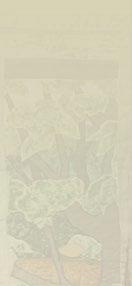
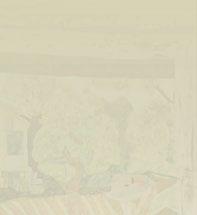
SECOND & COMMERCE / 11
|
Clarksville, TN (931) 647-1501
Springfield, TN (615) 382-4420 BATSONNOLAN.COM
|
Clarksville, TN (931) 647-1501
Springfield, TN (615) 382-4420 BATSONNOLAN.COM
|
Congratulations, Mrs. Amos, for this well-deserved statewide award! PO Box 555 Clarksville, TN 37041 | 931.551.8870 | artsandheritage.us
Clarksville, TN (931) 647-1501
Springfield, TN (615) 382-4420 BATSONNOLAN.COM
2021 Governor’s Folklife Heritage Award Winner Nominated by the Clarksville-Montgomery County AHDC
"When people talk about talent, I say my gift was in my hands."
Polymer clay doll Courtesy of the Artist
THE REEMERGENCE OF THE GATEWAY CHAMBER ORCHESTRA
BY BECKY WOOD, MANAGING EDITOR
Since its inception, the guiding force behind the Gateway Chamber Orchestra has been simple.
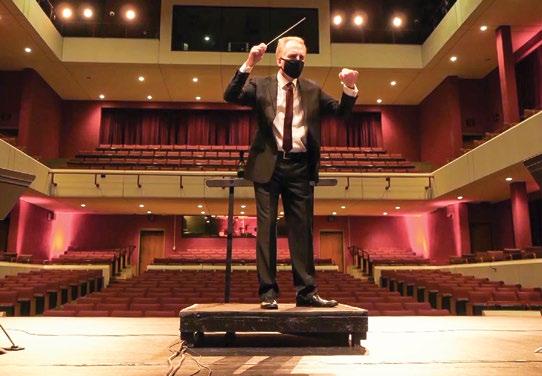

“If we came up with an idea, and we could fund it, then we could do it," explained Music Director Gregory Wolynec. “When the group started in 2008, there were no grand aspirations of numerous seasons, audience development, becoming our own nonprofit... It was a collection of musical friends who wanted to put on performances that would benefit our community.”
Such a philosophy has been liberating for the group, which has attracted a diverse array of renowned musicians for over a decade. However, the pandemic presented the GCO with an unprecedented roadblock. COVID-19 impacted all corners of the arts community, but the live performing arts faced unique challenges. Orchestras sit close together, and theatres and music halls were not built with social distancing in mind. The entire GCO programming experience needed to change.
“If we can come up with an idea, and we can fund it, and we can do it safely, then we can do it,” Wolynec emphasized.
This dedication has resulted in a variety of dynamic and unique virtual ventures that has kept the orchestra working through the absence of live concerts.
Since 2010, the GCO has brought hands-on outreach programs to thousands of students in Middle Tennessee schools. When school visits became impossible, they produced Magical Music & Timeless Tales , a series of 12 educational videos pairing elementary music teachers with GCO musicians for classic children’s stories and engaging music. The videos were given to schools, and it proved to
Courtesy of Gateway Chamber Orchestra
Courtesy of Goodwin Productions
be successful for the students, teachers and musicians.
Video production was applied to the concert experience with the show Beethoven @ 250: Humanity in 2020 and America’s Haydn Festival. Producing the Festival virtually meant that they could bring in outside artists like the St. Lawrence String Quartet, one of the top Haydn quartets in the world, as well as other musicians, authors and hosts. Beethoven @ 250 is available to view on the GCO’s YouTube channel. On top of celebrating 250 years of the German composer, the show includes music by African American composers George Walker and Jessie Montgomery.
“After a year that was so transformative, only celebrating Beethoven would have missed the point,” said Wolynec, highlighting the GCO’s dedication to programming music by underrepresented composers. “We saw social change, and we know that people of color are not represented within most orchestras or their programming.”
Venturing into the digital space did not stop with video production – the GCO was involved with the first American orchestral NFT, or non-fungible token. Composer Cristina Spinei approached Wolynec with the idea. With the orchestra on board, she wrote Prelude , making it the first commissioned work to be released in this way.
“Once upon a time, people made a recording, they sold that recording and it was pretty much impossible to copy that recording,” explained Wolynec. “People
bought it, and royalties would make their way back to the artists involved... Times have changed.”
Purchasing the NFT includes the original performance of Prelude with sheet music, and those sales provide a new funding model that greatly exceeds if they had recorded the piece and hoped that people bought it honestly. It generates much more money directly to the artists, who were hit especially hard by the pandemic.
2020. Their rendition of The Nutcracker brought together Tchaikovsky and Duke Ellington, in collaboration with the Nashville Ballet, for a show that will continue to grow as Clarksville’s Nutcracker tradition.

Moving into the new year, the theme for the GCO’s Masterworks series will be “Lift Every Voice.”
“For years, our programming philosophy has been an established masterwork paired with an overlooked treasure –something that the history books may have missed – paired with a work by a contemporary American composer,” said Wolynec. “Pieces that work side by side, so they help illuminate each other.”
Inspired by the events and conversations of 2020, they modified that slightly to make an even greater impact – one of the works will always be by an underrepresented composer.
“In a day and age when royalties are essentially a thing of the past, this is a way forward,” said Wolynec.
“Then the question is – what do you do now? All those projects performed very well, and are national things that also benefited our community,” said Wolynec. “So, how do you reemerge?”
In December, the GCO welcomed concertgoers back into Austin Peay State University's Mabry Concert Hall for their first live audience performance since February
In February, the GCO will present Tchaikovsky's Serenade for Strings, with works by George Walker and Jessie Montgomery, just in time for Valentine’s Day.
“And then things are going to get crazy.”
In March, the orchestra is taking on La Pasión según San Marcos by Argentine composer Osvaldo Golijov, one of the most important classical compositions of the last 25 years. Golijov was commissioned in the 1990s to compose a response to The St. Matthew Passion by Johann Sebastian Bach based on his own background, resulting in a stunning fusion of Latin and African musical styles.
CONROY, MARABLE & HOLLEMAN
SECOND & COMMERCE / 13
"It was a collection of musical friends who wanted to put on performances that would benefit our community.”
Decorated veteran. Dedicated reintegration advocate. Leading donor. A life well planned can offer each of us – any of us –
THE POWER TO GIVE.
Wolynec described this show as the biggest project they’ve ever done, as the piece calls for extra instruments like piano, accordion, guitar, hand drums and 30 different kinds of percussion instruments, as well as Afro-Cuban dancers and a Brazilian jazz contralto.
“The 18th performance of this piece in the history of the world will take place in Clarksville,” said Wolynec. “It will both enlighten our audience and educate our musicians.”
What could possibly come after that? A resurrection, of course.
In April, the Gateway Chamber Orchestra will perform Gustav Mahler’s Symphony No. 2, known as the Resurrection Symphony. It is the piece that inspired Wolynec to pursue classical music and conducting.
“We hope that this show will signify the reemergence of the Gateway Chamber Orchestra,” explained Wolynec. “On the national map as a cultural institution, and as a community-defining organization.”
gatewaychamberorchestra.com @GatewayOrch @GatewayOrch GatewayChamberOrch

The causes that inspire you are as unique as the life you lead. We all live and give differently, but the support of the right financial partner has the power to multiply generosity. It’s our privilege to help people make an impact – and to make our own.

Clark Nicholson, Amy Zimmerman, Frazier Allen Financial Advisors

50 Franklin Street Clarksville, TN 37040 T 931.553.2048 T 833.270.0640
www.raymondjames.com/fminvestmentservices
© 2020
Services, Inc., member FINRA/SIPC. Securities offered through Raymond James Financial Services, Inc., member FINRA/SIPC, and are not insured by any financial institution insurance, the FDIC/NCUA or any other government agency, are not deposits or obligations of the financial institution, are not guaranteed by the financial institution, and are subject to risks, including the possible loss of principal. The financial institution and the investment center are not registered broker/dealers and are independent of Raymond James Financial Services. Investment advisory services offered through Raymond James Financial Services Advisors, Inc. Raymond James is not affiliated with the organization mentioned. 20-BDMKT-4162 BS 3/20
14 / SECOND & COMMERCE
Raymond James Financial
F&M Investment Services is proud to support Customs House Museum and Cultural Center.
Courtesy of Gateway Chamber Orchestra
TENNESSEE WINGS OF LIBERTY MILITARY MUSEUM
BY MIKE OATES, FORT CAMPBELL HISTORICAL FOUNDATION PRESIDENT & CEO
The Tennessee
of Liberty Military Museum
Wings
will:
EDUCATE our citizens about the role of the U.S. Military in American history with a focus on civics.
HONOR the service of the 5th Special Forces Group, the 160th Special Operations Aviation Regiment and the 101st Airborne Division (Air Assault), along with other units that have served at Fort Campbell.
INSPIRE visitors to consider the value of personal service to country.
“The legacy of the millions of soldiers who served at Fort Campbell, in peace and war, deserves to be recorded for history. Their service teaches courage, tradition, leadership, values, character, a love of country – all things so important to the long-range security of our nation.”
-General J.H. Binford Peay III (Ret.)
This summer, construction is expected to begin on the Tennessee Wings of Liberty Military Museum (TWoLMM), with an expected grand opening during the Week of the Eagles in May 2025. The Fort Campbell Historical Foundation owes a great debt of gratitude to Mr. Jack Turner and CSM Robert Nichols (Ret.) for their vision and many years of support to make this dream a reality.
The Fort Campbell Historical Foundation will operate the TWoLMM in partnership with the U.S. Army and collaborate with regional school districts and higher education to provide a modern, interactive educational experience.

The TWoLMM is expected to attract over 300,000 visitors a year and will
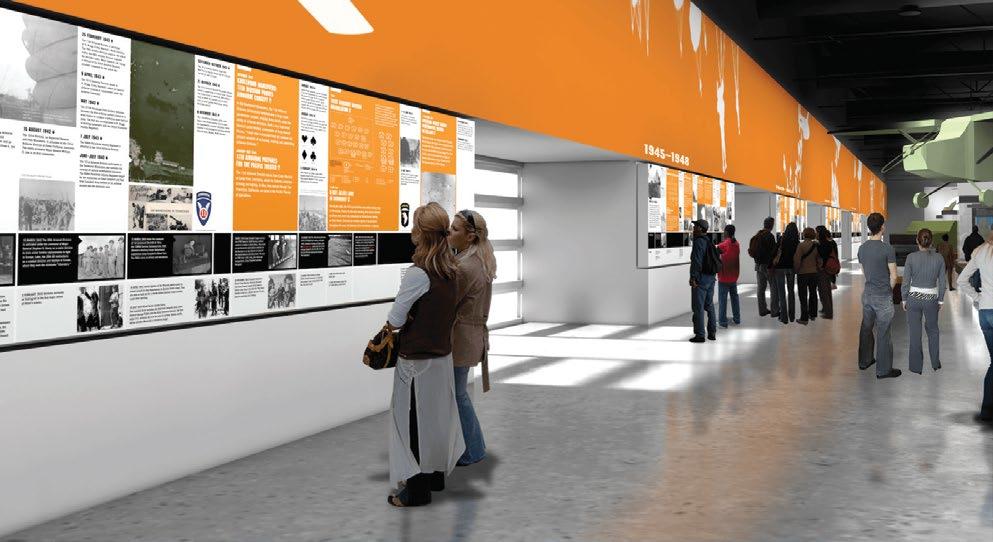
bring significant revenue into the region. It will be located on 33 acres of Fort Campbell with open access to the public without a security checkpoint at the intersection of Tiny Town Road and Highway 41A. The museum will have one of the largest indoor venues in the region for hosting events, along with on-site food and beverage availability.
The TWoLMM will preserve the legacy of the units, soldiers and civilians who called Fort Campbell home and who, through their service to our country, preserved the freedoms we all enjoy as Americans.
fortcampbell.com
BOTTOM:
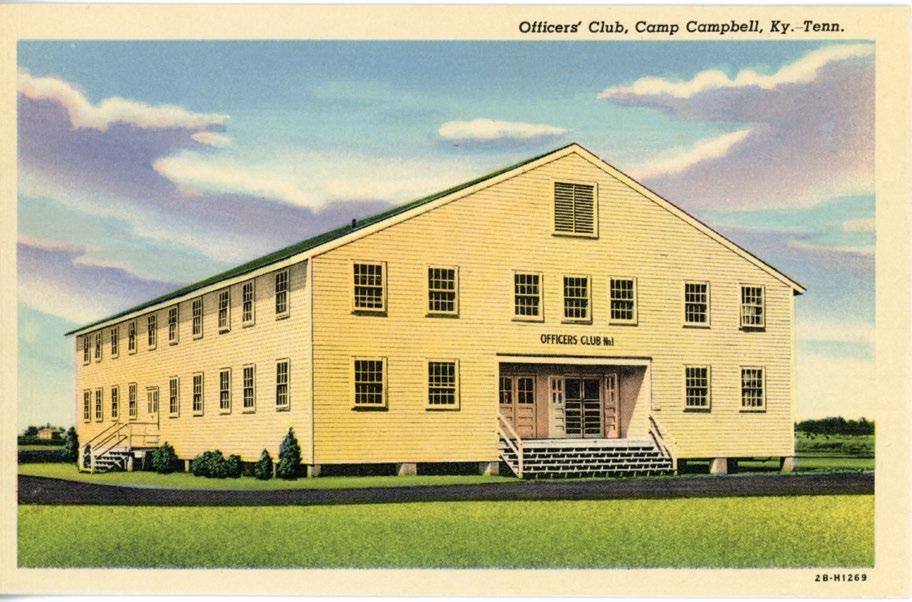

 TOP: Greetings from Camp Campbell Postcard, 1944
Officers’ Club, Camp Campbell Postcard, 1944
Courtesy of Austin Peay State University Felix G. Woodward Library, Archives & Special Collections
RIGHT: Construction of troop billets along Tennessee Avenue, May 1942 Courtesy of the Don F. Pratt Museum
BY JOHN O’BRIEN, DON F. PRATT MUSEUM DIRECTOR
TOP: Greetings from Camp Campbell Postcard, 1944
Officers’ Club, Camp Campbell Postcard, 1944
Courtesy of Austin Peay State University Felix G. Woodward Library, Archives & Special Collections
RIGHT: Construction of troop billets along Tennessee Avenue, May 1942 Courtesy of the Don F. Pratt Museum
BY JOHN O’BRIEN, DON F. PRATT MUSEUM DIRECTOR


On February 2, 1942, a bulldozer operated by the Forcum-James Company of Dyersburg, Tennessee pushed the first spade full of dirt to build a berm for a trestle bridge across U.S. Highway 41W. The bridge would connect the existing Tennessee Central Railroad line east of the highway to the construction site of a new Army camp on the west side. It was the very first project undertaken in the anticipated construction of the camp. The bridge spanned a lazy 28-mile two-lane highway crossing the very rural landscape between Clarksville, Tennessee and Hopkinsville, Kentucky to the north.
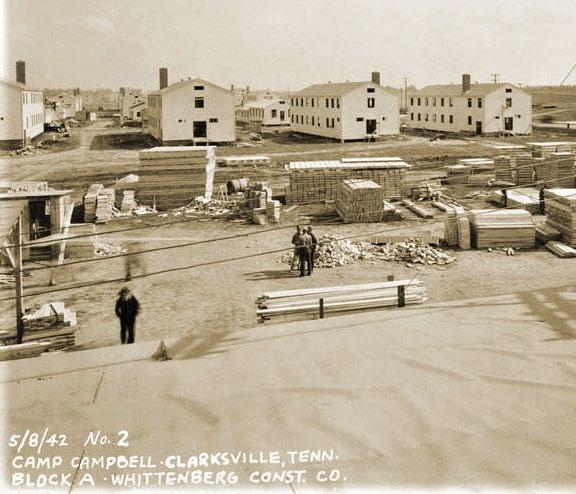

SECOND & COMMERCE / 17
“LOCAL SENTIMENT IN FAVOR OF A CAMP WAS VERY POSITIVE”
How the City of Fort Campbell Came to Be
A modern steel girder bridge with an elegant stone façade now rests on the base of that original and historic berm. The modern bridge spans the busy and broad four-lane U.S. Highway 41A, known to us as Fort Campbell Blvd. It crosses the highway near Gate 2 of that Army camp, which grew into the modern Army installation of Fort Campbell. The bridge is now graced with murals— those traveling north are welcomed to “Eagle Country,” the moniker for Fort Campbell that has been the home of the 101st Airborne Division “Screaming Eagles” for the past 65 years. Those traveling south are welcomed to “The Historic City of Clarksville.” The original bridge was once a lonely oddity on a large rural landscape. Today, it finds its place within the urban landscape where Clarksville and Fort Campbell have grown together to become almost a singular metropolitan entity.
Beyond their physical proximity, the two communities have also grown and overlapped historically and culturally.
Indeed, it is hardly possible to consider the history and culture of one without the other. Whereas the founding and development of Clarksville can be easily explained by post-Independence expansion, the confluence of rivers and conditions favorable for agriculture, it is a bit more mysterious to explain how the city of Fort Campbell came to be.

THE STORY OF HOW FORT CAMPBELL came to be takes place in the 18 months between June 1940 and December 1941. The spectacular fall of France in June 1940 alerted many in the United States to take necessary steps to prepare for the worst. Not all Americans, however, were for the type of preparedness that would lead to war. An almost 50/50 divide existed between those who advocated preparedness and those who advocated strict neutrality. In the space between those opposing points of view took shape a program that became known as incremental mobilization.
It was a simple observation made by an Army survey team in 1941 – “local sentiment in favor of a camp was very positive” – which gets to the heart of the mystery. It is a memorable phrase that even more so explains the symbiotic relationship between the two communities over the past 80 years.
The Army was to be brought from its size of 187,000 soldiers up to 1.6 million men by 1941 through a combination of federalizing the National Guard and instituting America’s first peacetime draft. Strict conditions for the use of these soldiers were put in place. They could not be deployed or used for any missions but for the defense of the continental United States. They were to be housed in camps that far exceeded the dismal conditions of the World WarI mobilization camps,
18 / SECOND & COMMERCE
Today, it finds its place within the urban landscape where Clarksville and Fort Campbell have grown together to become almost a singular metropolitan entity.
This 1947 schematic of the camp cantonment area shows the iconic rail bridge crossing US Highway 41W near Gate 2 in the lower left corner. Connectivity with the Tennessee Central Railroad was one of the key physical features leading to the selection of the site. Courtesy of the Don F. Pratt Museum
where austere conditions featured canvas tents, common latrines and the rapid spread of respiratory disease, and eventually the Spanish Flu. The question of the quality of these new mobilization camps rose to the level of Presidential politics. 1940 Republican candidate Wendell Willkie made the accusation that the camps would not be ready as draftees came on line. Democrat Franklin Roosevelt responded, “I can give assurance to the mothers and fathers of America that each and every one of their boys in training will be well-housed.”
The ambitious incremental mobilization plan required generous funding.
Munitions plants and seacoast defense were high priorities, but troop housing was the most pressing need. Congress passed four supplemental budget authorizations in 1940-41 providing a staggering $128 million earmarked for the troop housing construction program. A large infusion of government dollars provided the opportunity for politicians at all levels to lobby to “bring home the bacon” of extremely lucrative projects to their districts. As is often the case when immediate demand and large government appropriations collide, there was opportunity for graft, corruption, cronyism and plain old-fashioned incompetence.
RIGHT: Cover from Camp Campbell Memory Book, Military Photo Division, C.P. Clark, Inc., publisher, ca. 1942
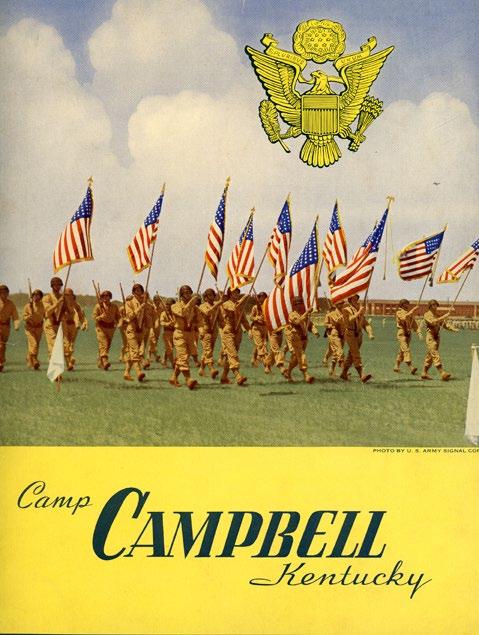
LEFT: Illustration from Camp Campbell Memory Book, Military Photo Division, C.P. Clark, Inc., publisher, ca. 1942

Archives Collection, Customs House Museum & Cultural Center
IN THE INITIAL MONTHS, MISTAKES were made. Poor site selection for the initial camps due to cronyism and political interference, inadequate engineer surveys and a lack of attention to transportation requirements led to millions of dollars of cost overruns and delays and resulted in a public outcry. In response, a Senate Special Committee to Investigate the National Defense Program was established. The committee, headed by Senator Harry Truman, vigorously went after mismanagement and political interference related to the construction of military camps. The committee laid down a series of reforms that, in essence, freed the Army from political interference in site selection and streamlined the construction management program.
In a remarkably short time, between June 1940 and March 1941, the Army built 40 veritable cities in locations across the nation, each capable of housing 10,000 to 60,000 men. Secretary of War Henry Stimson reported that these cities provided “all necessary utilities and conveniences, recreation buildings,
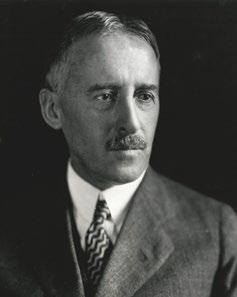

 The decision makers: Brigadier General Brehon Somervell, Army Chief of Staff General George C. Marshall and Secretary of War Henry L. Stimson.
The decision makers: Brigadier General Brehon Somervell, Army Chief of Staff General George C. Marshall and Secretary of War Henry L. Stimson.


20 / SECOND & COMMERCE you might not know we have life, home, auto, and business insurance. now you do. simple human sense® 931.552.4314 mscinsurance.com INSURANCE Enlisted Men’s Barracks and Mess Halls, Camp Campbell Postcard, 1944 Courtesy of Austin Peay State University Felix G. Woodward Library, Archives & Special Collections
theaters, service clubs, chapels, athletic areas, hospitals, bakeries, laundries and cold storage plants, and with a minimum hardship on the troops.”
However, in March 1941, the tension between preparedness advocates and neutrality advocates came to a head. Preparedness advocates articulated a need to construct 21 additional camps to accommodate a planned 3 million man increase in the size of the peacetime Army. Neutrality advocates applied the brakes to the spending. Faced with a shortfall in funding, Army planners decided to use the limited funds available to them in 1941 to conduct only assessments, preliminary surveys and construction planning for 21 future sites. No funds were made available for land acquisition or construction, but the strategy was to be ready to execute construction in all 21 locations if funds became available.
Preparedness was a large government program that represented an opportunity for state and local governments and boosters from civic organizations to attract federal dollars to their areas for economic development. The practice was not new, was not inherently corrupt and most certainly was not unfamiliar to chambers of commerce, city councils and similar public and private civic institutions. One might even suggest that since the early 1800s, the practice had been a distinctly American tradition and one greatly enhanced in the 1930s when government work projects were a key ingredient of the New Deal economic recovery programs.
CLARKSVILLE AND HOPKINSVILLE started early to attract the army to the area. The first and most sustained effort was by the Hopkinsville Chamber of Commerce. The Chamber promoted the use of an 18,000-acre Federal Game Preserve, now known as Pennyrile State Park, as a campsite. Aside from revenues and business gained by a large construction crew and soldier pay, the site of the camp would necessitate the paving of Kentucky Highway 109 (Dawson Springs Road), a long-sought economic development project.
Efforts in Clarksville were slower to start and tended to rely more on local government efforts than that of boosters. It took time for the Army to develop channels through which politicians could recognize and effectively lobby the system. The larger problem for Clarksville was that it had no large public acreage like the Federal Game Preserve with which to tempt the Army. Tempting the Army with other people’s property was problematic. Enthusiasm for a camp was muted at first, until after the July 1941 selection of a campsite when a sense of patriotic inevitability provided cover for politicians to aggressively support the camp and a wide range of infrastructure programs associated with the federal largess attached to camp construction.
THE INTERSECTION OF ARMY NEEDS AND THE HOPES of local civilian boosters and politicians occurred in the early spring of 1941 when an officer board considering camp locations was dispatched to conduct a reconnaissance in response to the Hopkinsville Federal Game Preserve proposal. The Army team came looking for a site for an armor camp, prepared with a set of no-nonsense criteria developed from the Truman Committee recommendations by which to assess sites. One set of criteria considered suitability for training; the other set considered the availability of resources necessary to sustain a city of 33,000 soldiers.
The team quickly dismissed the Preserve itself as much too small (18,000 acres vs. a required 75,000 acres), and the adjoining terrain was too hilly with steep crags that made it unsuitable for armored tracked vehicles. However, while the team was in the Hopkinsville area, it did have the opportunity to visit and assess the much more favorable terrain in south Christian County in the vicinity of the small town of LaFayette, Kentucky. The team discovered sprawling terrain to the south and west that would be most suitable and favorable for armor training. The broad, rolling farmland and temperate climate looked and felt like central Europe where soldiers were destined to fight.
The second set of criteria addressed the availability of logistical resources necessary to build and sustain a city of 33,000 soldiers. An Army city needed electricity, water, road and rail connectivity, a skilled labor force upon which to draw and resources to provide for the recreation of a large peacetime Army population. The team found the area between Hopkinsville and Clarksville rich and abundant with these resources, such as the new TVA trunk line running north of Clarksville for electricity, the Red River for providing sufficient water, connectivity to the U.S. Highway System, easy connectivity to the Tennessee Central Railroad, a skilled and available labor pool and recreation resources like Dunbar Cave. But there was one more thing that really caught the attention of the reconnaissance team: “local sentiment for a camp was very positive.”
THE RECONNAISSANCE TEAM PREPARED A FAVORABLE report. It was submitted in a selection process that included 250 locations vying for 21 spots. The team identified a general location for the camp that encompassed 100,000 acres, including the land from two counties in Tennessee (Montgomery and Stewart) and two counties in Kentucky (Christian and Trigg). They named the proposed location the Tennessee-Kentucky Armor Camp. If the selection process were to depend on a vote from Congress, the area would have had the support of four U.S. Senators and two members of the House.
SECOND & COMMERCE / 21
The broad, rolling farmland and temperate climate looked and felt like central Europe where soldiers were destined to fight.
But the decision was not to be political. Astute politicians studiously avoided even the appearance of interference that had been so condemned in the popular Truman Committee recommendations, but they did lobby well within the boundaries of our political tradition in expressing positive support on behalf of their constituents for a camp. One of those senators was Alben Barkley of Kentucky, who was the powerful Senate Majority Leader. He was attacked in the Kentucky press for lack of enthusiasm in using his position to influence the outcome of projects that would benefit his state. Barkley aggressively defended his non-interference position in an oped published in the Paducah Sun. And so it was that the report stood on its own merits.


The 250 reports from the field wound their way through an Army selection process between May and July 1941. The process was conducted at the highest levels. The reports were consolidated at the Army Quartermaster Construction Division commanded by Brigadier General Brehon Somervell. Somervell and his staff presented a final prioritized list to Army Chief of Staff General George C. Marshall. Marshall presented his finalized list to Secretary of War Henry L. Stimson, who personally approved the selection of the 21 future camps on July 16, 1941.
THE WHISPER OF “LOCAL SENTIMENT FOR A CAMP was very positive” echoed throughout the process from the reconnaissance team’s report through final selection. An appropriate balance between the Army’s strict analytical criteria for a camp and a recognition of local political support required mature judgment – Somervell, Marshall and Stimson had that judgment. It was said of Somervell, although he was “committed to building only in a location favorable to military training and expeditious construction, he did not object to choosing a site that also enjoyed political support, hence, lobbying by state officials and legislators helped secure the designation of the camp.”
That whisper has continued to echo over the past 80 years. The historical and cultural bond that has intertwined the two communities has only deepened with time. To the benefit of both, long may it continue.
fortcampbell.com/don-f-pratt

22 / SECOND & COMMERCE
But there was one more thing that really caught the attention of the reconnaissance team: “local sentiment for a camp was very positive.”
Senate Majority Leader Alben Barkley, Kentucky (D) and Senator Kenneth McKellar, Tennessee (D)
GATEWAY TO EAGLE COUNTRY
Local History Inspires New Fort Campbell Bridge Mural
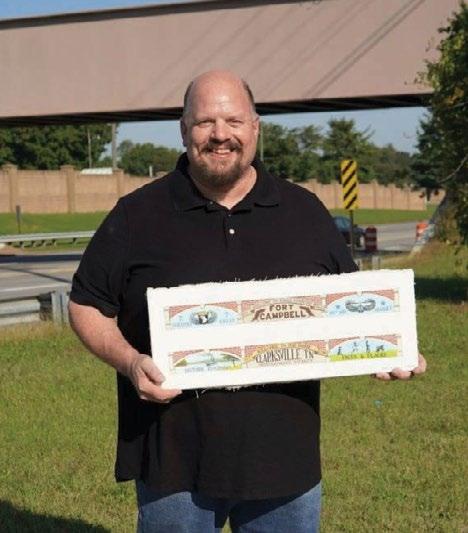
 BY BECKY WOOD, MANAGING EDITOR
BY BECKY WOOD, MANAGING EDITOR
Regardless of which direction you are traveling on Fort Campbell Boulevard, a new mural is ready to welcome you across the Tennessee-Kentucky line.
Two years ago, in January 2020, the Montgomery County Public Art Ad Hoc Committee put out a call for artists to design a mural that would adorn the railroad bridge crossing the bustling boulevard near Gate 2 of the Army base.
The Committee, in collaboration with Montgomery County Mayor Jim Durrett, combed through numerous submissions, ultimately choosing the work of local artist Paul Jones. The original artwork, acrylic on handstretched canvas, showcases Jones’ dedication and attention to detail.
Jones has called Clarksville home since moving down from Upstate New York in July 2014. Coming from a large artistically-inclined family, Jones enjoys painting in his free time when he is not working at Trane. He was not aware of the Committee’s contest until a coworker brought it to his attention. By that time, the deadline was already fast approaching.
Knowing the dimensions he had to work with – a space 106 feet long and 10 feet tall – he approached one side of the bridge at a time, compiling images and symbols that he felt represented the neighboring towns. He explored both the Army base and Downtown Clarksville for research and inspiration, jotting down notes and quick sketches.
“I drove around Downtown Clarksville, looking at brickwork and arches and keystones, thinking
about how that might translate to a mural,” explained Jones. “I thought, what’s the history around here? Commerce, the rivers, tobacco trade... I did a lot of research on Wilma Rudolph, John Montgomery and Fort Defiance.”
These architectural features and city icons came together in the finalized hand-painted design. The end result is simple and welcoming, bringing together the old and the new. Jones’ original painting was converted into a vector file that could be enlarged and turned into a vinyl wrap by local print shop Gerald Printing. The project was completed in September 2021 as the wrap was applied to the bridge.
Jones is proud to be involved in the expanding collection of public art that Montgomery County has to offer, emphasizing how these projects accent the existing charms of Clarksville and Fort Campbell.
“It helps take away the ho-hum,” said Jones. “Once newcomers come to town and notice these beautification efforts, they start taking pictures, they start sharing those pictures... it all gives people another reason to want to visit Clarksville.”
Paul Jones stays busy with private commissions for paintings and pyrography by local businesses and individuals across the country. Other projects with designated funds by the Montgomery County Public Art Ad Hoc Committee include the iron sphere at Downtown Commons and the Tennessee Triumph Women’s Suffrage monument at Public Square.
SECOND & COMMERCE / 23
Courtesy of Michelle Newell, Montgomery County Government Communications Director
Artist Paul Jones with his original artwork
VOLUNTEER SPOTLIGHT: BILL HAGGE
As you walk around a gallery and peruse the artwork and artifacts, you may not realize how much work goes into creating a dynamic environment in which those exhibits can live.
Bill Hagge has over 20 years of experience building those environments with the exhibits team at the Customs House Museum & Cultural Center. He began volunteering at the Museum in September 2001, after some encouragement by an employee at the time.

“I didn’t know what I was getting into,” laughed Hagge, who turned to volunteerism after retiring from a career in civil service.
As a volunteer with the Museum’s exhibits department, he helps with every aspect of the process, from preparation to installation to breakdown. He collaborates closely with Randy Spurgeon, Exhibit Preparator.

“Bill has been a great help these last 20 years,” said Spurgeon, who has 23 years of experience at the Customs House Museum himself.
Many of Hagge’s favorite Museum memories are tied to specific exhibits, as each one presents a unique set of challenges and demands. Whether he’s building a rocking horse for the children’s area or a 90% scale model of the Bathysphere, his assignments truly run the gamut. An exhibit may require him to hang artifacts from the ceiling, or build heavy-duty pedestals on which large statues can rest.
He even helped build a house for a large Wizard of Oz exhibit.
“Dorothy had to have her house torn up after that tornado... so we built an old house, tilted and falling apart in the gallery,” explained Hagge. “Museum visitors had to walk through the old house to get to the Emerald City.”
Dorothy’s house was all in black and white, while the sparkling
Emerald City was built in color. Large projects like these stand out in Hagge’s memory, but even the smaller jobs make a big difference to the Museum staff.
“Bill has been such an asset to the exhibits team,” said Exhibits Curator Terri Jordan. “We average 25 to 30 shows a year, which often require fabrications, plus all the work that goes into changing out exhibits within short timeframes. Bill’s assistance with prepping walls, painting and constructing props has been a great help to us. I have always appreciated and relied on his knowledge, experience and artistic eye.”
The team began referring to Hagge as the “Curatorial Watchdog,” because of his ability to suggest tweaks and problem solve within an installation – and keep Randy on task from distractions.
Hagge received a volunteerism award from the Tennessee Association of Museums in 2019, though he is quick to acknowledge that he is not in it for the recognition.
“I was surprised – Randy snuck that one in on me,” said Hagge.
Even after two decades, Hagge’s passion for the work is clear. He hopes prospective volunteers share that passion and look forward to what the Museum experience can offer them.
“Working at the Museum introduced me to many things that I had never been introduced to before,” said Hagge. “It’s an education.”
The Museum is always looking for volunteers to share their time and experience with our visitors!
Visit customshousemuseum.org/ become-a-member/volunteer for more information about volunteer opportunities.
"I have always appreciated and relied on his knowledge, experience and artistic eye."
Museum Volunteer, Bill Hagge (front) with Randy Spurgeon, Exhibit Preparator and Terri Jordan, Exhibit Curator
Necklace,
SOUTHERN CHARMS
Necklace,





Ring, $8 Heidi Teague Clarksville, TN repurposedelements.net
Bracelet, $30 Creative Musings by Hilda Walker Clarksville, TN hildasmusings.etsy.com
Necklace, $12 Laurel Mitchell Dickson, TN
SECOND & COMMERCE / 25
@seasonsmuseumstore Shop local and find hand-crafted jewelry from Tennessee artists at Seasons: The Museum Store. made in middle tennessee
$15 Heidi
$25 Cuff
$29 Spiral
$20 Midi Ring, $25 Patsy
$40 Johnny LTD Nashville, TN johnnyltd.com Earrings,
Teague Earrings, $28 Patsy Sharpe Stone Bracelet,
Bracelet,
Ring,
Sharpe Clarksville, TN
$20 Heidi Teague
FIRST THURSDAY ART WALK
Visit the Museum for free from 5-8 PM on the first Thursday of every month for First Thursday Art Walk, presented by the Downtown Clarksville Association.
FIFTH SATURDAY DONATION DAYS

In any month with five Saturdays, any monetary donation to the Museum is your admission on the fifth Saturday. Upcoming dates: 1/29, 4/30, 7/30
MUSEUMS FOR ALL Museums for All is a nationwide program that offers reduced admission to those who receive SNAP benefits. Present your EBT card and valid picture ID to receive reduced general admission for up to six individuals.
Admission prices: $3 for Adults & Children 3+ Free for Children 2 & under

BLUE STAR MUSEUMS
From Armed Forces Day in May through Labor Day in September, Blue Star Museums offers free admission to the nation’s active-duty military personnel and their families, including National Guard and Reserve.
Admission is good for the military ID holder and up to five family members.
See a list of all programs and details: customshousemuseum.org/visit/hours-information

26
VISIT THE MUSEUM WITH FREE OR REDUCED ADMISSION!
BY BECKY WOOD, MANAGING EDITOR
It has now been over 50 years since art historian Linda Nochlin tackled the question “Why Have There Been No Great Women Artists?” in her pioneering 1971 ARTnews essay. The conclusion, of course, can be condensed not to a scarcity of talent, but of access and opportunity.
Five decades may have passed, but the obstacles that plague this conversation continue. According to a 2019 study by Artnet News and In Other Words by Sotheby’s, only 11 percent of acquisitions and 14 percent of exhibitions by the country’s top museums between 2008 and 2018 were of work by women artists. Of that total, less than 4 percent were by African American women. There collectively appears to be more growth than actually exists – shows by women may receive more press and promotion, resulting in a split between perception and reality.
The Bennett Prize was established by Steven Alan Bennett and Dr. Elaine Melotti Schmidt in 2018 with the hopes of propelling the careers of women painters and empowering new artists. The biennial $50,000 prize is the largest art award ever offered solely to women figurative realist painters, or those who paint in a style in which the realistically depicted human figure is a principal focus of the work.
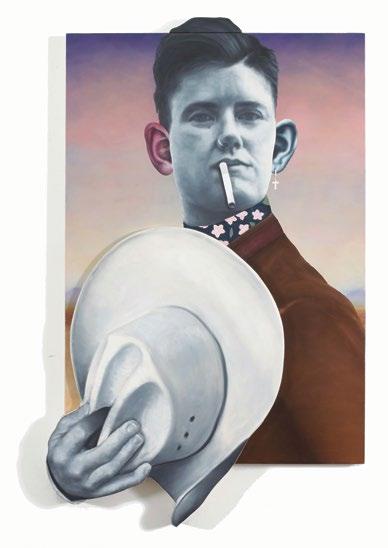

The Prize provides support to a selected artist over two years, allowing the winner to dedicate that grant period to producing a solo exhibition that will travel the country. Rising Voices 2 includes paintings by 2019 Prize winner Aneka Ingold and by the ten 2021 Bennett Prize finalists, including 2021 Prize winner Ayana Ross.

TOP TO BOTTOM:
More Charming, More Vague
Oil on canvas, 2020 Courtesy of the Artist
®
“We continue to be gratified by the increasing reach of The Prize,” said Bennett. “We understand that we are exposing, and being exposed to, a new, deep and rich vein of talent that otherwise might not have come into view.”
-Steven Alan Bennett & Dr. Elaine Melotti Schmidt
The Customs House Museum & Cultural Center is one of only six museums in the country to host the traveling exhibition. Other finalists on display will include SophiaYemisi Adeyemo-Ross, Tanmaya Bingham, Chloe Chiasson, June Glasson, Holly Keogh, Lavely Miller, Rebecca Orcutt, Su Su and Amy Werntz.
Rising Voices 2: The Bennett Prize for Women Figurative Realist Painters will be on view in the Crouch, Orgain and Bruner Galleries from February 3 to April 24. This exhibition is organized by the Muskegon Museum of Art and The Pittsburgh Foundation.

Sexy Giggles
Acrylic,
God
Acrylic on paper on panel, 2020 Courtesy of the Artist
SECOND & COMMERCE / 27
"The quest for equality in the arts, both in gender and in race, has been, to put it kindly, a slow slog... We firmly believe that The Bennett Prize is an important tool for moving women painters and figurative realism forward.”
Holly Keogh
Chloe Chiasson
Daddy Made a Soldier Outta Me Oil and acrylic on canvas, 2021 Courtesy of the Hort Family Collection
Tanmaya Bingham
colored pencil, watercolor, and glitter on panel, 2020 Courtesy of the Artist
Lavely Miller
Shot Me in the Face and Then I Saw (Blue Shirt)
2019 BENNETT PRIZE WINNER: ANEKA INGOLD
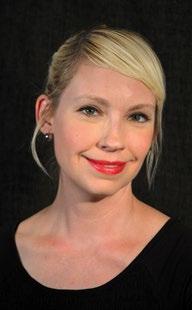
Aneka Ingold’s mixed media works explore the female experience across time and cultures. Her solo exhibit Transfiguration chronicles a remarkably transformative time in her life.

Second & Commerce: Your work is full of such rich symbolism. How do all those pieces come together with the central female figure?

Aneka Ingold: The figure is always the most important part and I build around her.
I usually collect a bunch of images – I cut pictures out of books and magazines, I find patterns and fabrics that I like, I take photographs of myself or friends might model for me – and I start putting them into groups. I don’t know why, but somehow, they seem connected and that’s going to tell the story. Then, I start with the female figure and I map out where she’s going to be in the space. If I can’t get the figure right, then nothing else in the piece really matters. Once she’s there, then I can start using some of these other images that I've found and decide where I want them to go, how she’s going to interact with them and what colors they are going to be.
In this show, the first piece I made was Devil’s Bread, which is a selfportrait about my divorce. The symbols are very personal and specific for me— and that’s not always true with all the pieces. In some of them, I work much more intuitively and the story comes out of me, but it’s not as specific or emotional. It might just be listening to my psyche.
S&C: What is it that draws you to paint people, and in your case, women specifically?
AI: I’ve always just wanted to make work about my experience as a woman. There were so many things that I had been through personally that I needed to process and get out. I also heard stories from friends who had been through things, stories that my mom or my grandma had told me— all these things that I was processing about the woman that I was becoming, or wanted to become. Through watching my female friends around me have that same struggle... the work naturally became that. And I don’t think I have a specific agenda that I push to people about what the female experience is, but all those themes just naturally come out when I'm working. I hope to share some of my perspective on those things.
S&C: The Bennett Prize was created in response to the numerous obstacles that women artists often face in contrast to their male counterparts in the industry. Are these issues that you feel you are confronting with your work?
AI: My personal experience of being able to express myself at all has been quite a journey. I think that as a Midwestern Christian conservative girl growing up, I didn’t really know to find my voice, let alone be vocal
28 / SECOND & COMMERCE
Aneka Ingold
Fecundity
Mixed media on paper, 2021 Courtesy of the Artist
Aneka Ingold Devil’s Bread
Mixed media on paper, 2020 Courtesy of the Artist
and have people listen. I think that continues to be a struggle for women, but it is changing – we’re seeing more women in roles of power and leadership.
I hope that we’re seeing that now too in the art world. We sometimes get diminished to “oh, well women haven’t had the same sales that men have” – but we haven’t been given the same opportunities. You can’t diminish it to that evaluation of success. The Bennett Prize is a great example of finally giving women their own platform... I am blown away by how much winning The Prize changed the way I thought about myself personally. It is showing women that they are valuable and they are valued, and that their stories need to be heard. I believe that The Prize is a huge step forward, and it changed the way I felt about myself as a woman and an artist.
S&C: When you were named the winner of the inaugural Bennett Prize in 2019, you had no inkling of how close the divorce and the pandemic were to follow.
AI: As much as I really don’t want to have to go through something that difficult or painful again, it has made me so much stronger. It really forced me to see what I was capable of. Through those experiences, I didn’t start making work right away... I just couldn’t. I was juggling being a single mom and still working, but I funneled all that energy into the artwork. It was such a catharsis. I am so, so grateful that I had the goal, that I had the deadline, that I had the opportunity to have this show, because I think in many ways that it saved me. I was in such a dark place and it helped me feel empowered, it pulled me out of it. Instead of feeling sad or angry, I felt stronger and lighter because I could process
all these experiences through the artwork... It came at the perfect time; I could not have needed it any more than I did. It gave me a drive and it forced me to be productive even if I didn’t want to be, and it was healing.
S&C: What do you want Museum visitors to take away from the pieces in Transfiguration?
AI: The more I work, the more I naturally want to tell women’s stories. I find it so fulfilling, especially when people come up to me and start sharing their stories and we start laughing, or we start crying – whatever it is, you learn that you are not alone, and you bond through art.

For example, when I did my piece Postpartum, which is about postpartum depression after my daughter was born, I spoke to other women who had gone through postpartum depression, or just postpartum experience in general. It’s challenging, it’s emotional, it’s personal, and people just don’t talk about it. I want to provide these opportunities for conversations that women might not normally have because they’re too afraid to share their stories, or they are ashamed of their experiences because they think they are the only one... I want to keep those conversations going, even well beyond the artwork.
anekaingold.com @anekaingold
This interview has been edited for length and clarity.
SECOND & COMMERCE / 29
Aneka Ingold
Symbiosis (Diptych)
Mixed media on paper, 2021 Courtesy of the Artist
2019 BENNETT PRIZE WINNER: AYANA ROSS
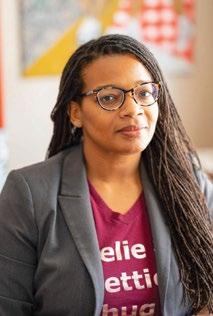
Ayana Ross began her professional career as a designer in the fashion industry, later turning to art education. Now, as a full-time artist, Ross’s work explores identity and cultural awareness in the everyday lives of African Americans in the American South.

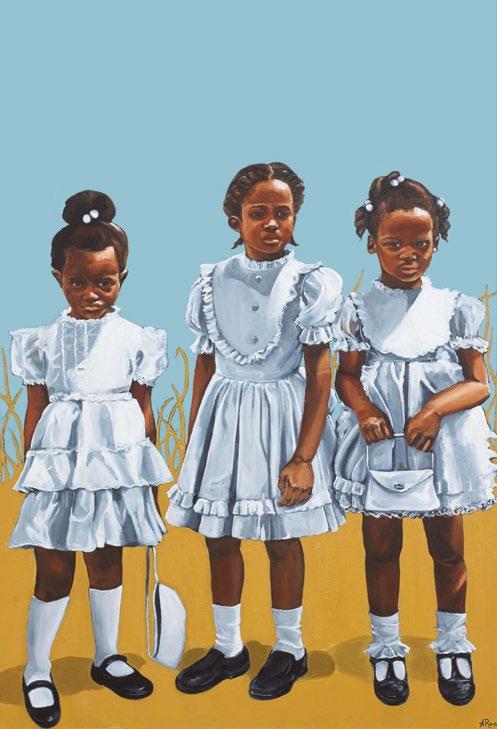
Second & Commerce: Rich colors and patterns are a staple in your work. Are those choices influenced by your background in fashion design?
Ayana Ross: I think it definitely comes from my history in material design, but it was not necessarily a conscious decision. There is a sense of “oh, I get what I’m doing,” and I can put those pieces together. I also have always had an interest in nature, and early on I used to paint a lot of botanicals. It is a wonderful way to incorporate the things I enjoy painting all in one piece, and use them to tell the story.
S&C: The Bennett Prize was created to confront the lack of gender parity in the art industry – how does that conversation fit into your journey as an artist?
AR: In terms of being an artist and being a woman, there are certainly challenges. For me, being a woman of a particular age, and being a mother and a wife – it's not the traditional narrative that we have heard of artists. I don’t fit that mold, and my lifestyle doesn’t fit that lifestyle.
In terms of the content of my work, I paint a lot of children and women... that is where my stories take me, those origin stories. As a woman artist painting children, I think about the challenge of being taken seriously. Will I be taken seriously enough if I’m not painting other things that traditionally may have been expected by male artists? I try not to let those things be a factor and forge ahead anyway. In the end, it would be an honor to be among those who are remembered as having been a good artist – not a good woman artist, or a good Black woman artist, but a really good artist in general. That's my goal, and I keep working towards that.
S&C: Does this award validate the choices you’ve made to reach this point in your career?
AR: The Bennett Prize gave me an opportunity that I was working really hard to create for myself, but was not making a lot of headway. I was working towards being a full-time artist, but trying to do that while being a mother and juggling other things... art is so all-consuming. If you want to be an artist, you have to BE an artist. I was working as a teacher full-time, I had my kids and my husband, but I would get up crazy early in the morning to paint before I went to work so I could still get my full-time hours in painting. Winning
30 / SECOND & COMMERCE
Ayana Ross SWBAT: Learn Oil on canvas, 2020 Courtesy of the Artist
Ayana Ross
My Turn Oil on canvas, 2020 Courtesy of the Artist
The Bennett Prize catapulted me to a different place where I could transition [to being a full-time artist] a lot faster and smoother, and it has given me that exposure. In the midst of all the challenges that surround us... good things still come. I'm grateful for that.
S&C: What inspired the three pieces featured in this traveling exhibition?

AR: [The paintings My Turn and Girls in White Dresses] were intended to be a celebration of my heritage, and the pride I have in my upbringing.

The one of the little girl at the desk, SWBAT: Learn, I painted at the start of the pandemic when schools were closed. I was thinking about all the debate around whether kids should be in school or if they shouldn’t, if can they learn virtually... and I was thinking about how not everyone learns the same way, or has the same experiences. It is a reminder that what may be good for one is not necessarily good for all, and how great it would be if we were all open to the possibilities of options for everyone.
ayanaross.com @ayanarossart

This interview has been edited for length and clarity.
115 Franklin St Clarksville, TN Rivercityclay@gmail.com 931-542-6615


SECOND & COMMERCE / 31 Pottery Studio | Art Gallery
B R I N G I N G T H E A R T O F H A N D M A D E P O T T E R Y T O D O W N T O W N C L A R K S V I L L E Rivercityclay.com LET YOUR CLAY JOURNEY SHOP BOOK A CLASS BEGIN
Ayana Ross
Girls in White Dresses
Oil on canvas, 2020 Courtesy of the Artist
There’s always something going on at the Customs House Museum. Share your visit with us! Tag us for a chance to be featured on our social media, in the Museum or right here in Second & Commerce.
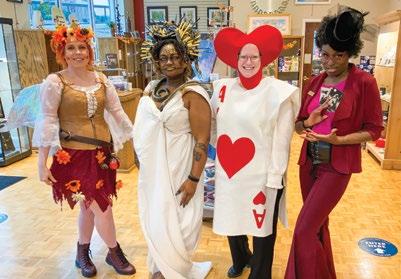




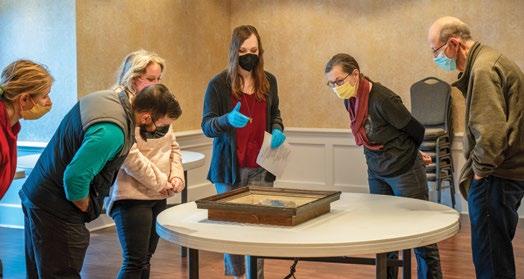
CONNECT WITH US
customshousemuseum.org
@customshousemuseum

#customshousemuseum
@bella_wisanee

32 / SECOND & COMMERCE
@cdcharltonartwork
Are you traveling for Spring Break?
Remember to pack your Museum membership card before heading out on your next adventure!
As a Customs House Museum & Cultural Center member, you have access to free admission and special discounts at museums and other institutions across the country. Museum members can participate in four different reciprocal programs that include membership benefits at hundreds of locations nationwide.*
Start discovering! Flex your Museum membership benefits with a day trip to some of these amazing institutions:
ALL MEMBERSHIP LEVELS Time Travelers
Tennessee State Museum (Nashville, TN)
FRIEND LEVEL & ABOVE Southeastern Reciprocal Membership Program
Hunter Museum of American Art (Chattanooga, TN)
Cheekwood Estate & Gardens (Nashville, TN)

Discovery Park of America (Union City, TN)
Downing Museum (Bowling Green, KY)
River Discovery Center (Paducah, KY)
Yeiser Art Center (Paducah, KY)

FRIEND LEVEL & ABOVE Reciprocal Organization Of Associated Museums Program
Frist Art Museum (Nashville, TN)
National Corvette Museum (Bowling Green, KY)

BENEFACTOR LEVEL & ABOVE
North American Reciprocal Museum Association Program
Tullahoma Fine Arts Center (Tullahoma, TN)
The International Towing & Recovery Museum (Chattanooga, TN)
Janice Mason Art Museum (Cadiz, KY)
Gallery on the Square (Franklin, KY)
Owensboro Museum of Science and History (Owensboro, KY)
*Reciprocal
recommend calling the institution ahead of time, as lists are subject to
without notice.
We
change
See the full list of institutions for each program: customshousemuseum.org/become-a-member
membership
200 S. Second Street Downtown Clarksville 931-648-5780 customshousemuseum.org CheekwoodEstate&Gardens
Park of America
programs depend on
level
Discovery
S H O P
DI N E
FR OL I C
BA NK


myfmbank.com
.
.
.
. DO W N T O W N C LARKSVI L L E Member FDIC NMLS ID 518158 Clarksville Montgomery County Historical Museum d.b.a. P.O. Box 383 Clarksville, TN 37041 customshousemuseum.org NONPROFIT ORG. U.S. POSTAGE PAID CLARKSVILLE, TN PERMIT NO. 530